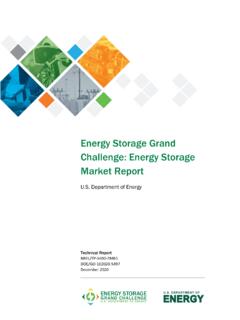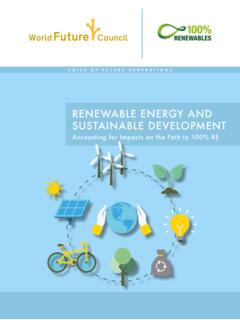Transcription of Power Market Study 2030 A new outlook for the energy …
1 Power Market Study 2030A new outlook for the energy industryHamburg, April 2018 Monitor Deloitte 20182 Management summaryGeneral Market environment:The traditional utilities business remains under significant pressure; major trends identified in Deloitte s 2015 Power Market Study remain valid for generation, distribution and consumptionNew drivers of change:Major players have made necessary adjustments,but new Market realities have emerged generation is driven by consolidation and recovering wholesale prices, distribution by the interplay between high-voltage transportation requirements and need for new revenue streams, and consumption by changing customer expectations and transformation needsImplications:Based on the new Market environment, utilities have to re-prioritize their business model portfolio and investment decisions, as well as to adjust their Target Operating Model into an even clearer set-upMonitor Deloitte 20183 Main challenges and trends of Deloitte s Power Market Study 2025 published in 2015 have been confirmed over the last 2 years and are largely still validRecap.
2 Power Market Study 2025 (1/2) Deloitte s 2015 Study has been focusing on the future of the Power Market Main challenges remain: Generation: Ongoing margin pressure as over-capacity is only slowly reduced Distribution: Imbalance of consumption and generation remains a challenge, increasing number of dispatching incidents Consumption: Customers have the option to choose preferred technology for Power generation Consequences are being realized ( through portfolio adjustments), the industry seems to have bottomed outPower Market Study 2025 ImplicationsPower Market Study 2025 The traditional business model for utilities is gone,let s talk about how to build the future 2015 Deloitte Consulting GmbHTechnological, social and most of all regulatory influences changed the utilities industry over the last 10 years for good, resulting in significant challenges in terms of Market valuation, profits and returns for utilities1 Current SituationKey issues exist in three areas: In generation, over-capacity eliminates spreads; in distribution, increasing geographical disparity exists between generation and demand.
3 In consumption, new segments with diverse behaviors and needs arise besides the traditional consumersKey Issues2To respond to these challenges, utilities need to fix current business, invest in intelligent and commercially optimized demand/supply balancing solutions, become more customer centric and reposition for new business modelsImplications3 Monitor Deloitte 20184 The good old days are gone for good a mere evolution is not sufficient,a real transformation is requiredRecap: Power Market Study 2025 (2/2) General confirmationof Power Market Study 2025, however, some surprises have occurred: Very effective auction model for renewables Extent of portfolio adjustmentsacross all major utilities Speed of storage technologies to become relevant Regulatory-driven decarbonization(introduction of CO2taxation and potential lignite phase-out) no longer a vision of the future Further consolidation in large-scale traditional generation expectedLowHighLong-termShort-termTime of occurrenceImpact for utilitiesMaturity of renewablesE-Mobility(Large-scale)
4 Storage / P2 GRegulatory-driven decarbonizationIoT / convergenceMicro-grids1 Portfolio adjustment/ Market consolidation2015 projection Adjusted projectionNew topicsEnergy-as-a-ServiceBlockchain1 Microgrids include Peer-to-Peer-Trading Platforms and energy Communities Major trends and their developmentObservationsMonitor Deloitte 20185 Challenges have not diminished new Market realitieshave appeared to which utilities have to Deloitte 20186 The three major value chain segments are still a valid basis for industry analysisOverview Traditional commodity business not profitable(for B2B no margin recovery, for B2C potentially slight increase through automation expected) Shifting customer needs and industry convergence require transformation and cost-effectiveness Inexpensive renewable energies and maturing storage solutions push importance of micro-grids High-voltage transmission still essential to balance unequal supply and demand Convergence of infrastructures ( Power and gas, telecommunication, data, mobility) Further regulatory push towards decarbonization (Paris Agreement), over-capacities will decrease (nuclear, lignite phase-out) Recovering wholesale Market prices (50-60 EUR/MWh).
5 Renaissance of natural gas ( stranded assets ) to provide system servicesGenerationDistributionConsumptio nRelevance of Micro-grids, extension of (critical) infrastructure ecosystemDe-commoditization,convergence and service cost reductionConsolidation in large-scale generation, Market forcesrelevant againMonitor Deloitte 20187 Wholesale prices are improving relieving the profit situation for utilitiesGeneration | Price developmentSource: EPEX; Credit Suisse: European Utilities 2018 outlook (2017); Federal Network Agency (BNetzA); Agora Energiewende: Jahresauswertung 2017 ; Monitor Deloitte analysis Germanywill potentially see upturn in wholesale Power prices (nuclear phase-out by 2022 + potential coal/lignite) Nuclear phase-out: remaining nine nuclear plants shut down by 2022 latest Limited future for coal: 13g EnWG already leads to shut-down of approx. 10% of coal plants by 2019 Price fluctuations on spot Market more pronounced 2017: negative prices during 146 hours (most ever recorded); many hours with prices >100 EUR/MWh volatility on intraday Market high as well.
6 Shows increasing need for flexibility due to rising PV & wind capacityGerman wholesale Power price (spot) (EUR/MWh)2831333843524602040602014201633 2013 EUR/MWh2030e50-6020172015201120102012146 9712664645615128891780501001502016201520 1420122017201320102011 Number of hours with negative wholesale Power prices and hours with prices >100 EUR/MWhHours with spot prices > 100 EUR/MWhHours with negative spot pricesExpected utilities profitability growth 2017-2020 (CAGR in %) developmentConsiderationsMonitor Deloitte 20188 However, large-scale conventional generation will be subject to further consolidation, while their relevance for system stability remainsGeneration | Consolidation in fossil generationSource: Federal Ministry for Economic Affairs and energy (BMWi); Monitor Deloitte analysis Traditional vertically integrated utilities business model is increasingly challenged Merger wave in conventional generation Capital-intensive business, large players will set the pace Need for new (gas) Power plants for security of supply at least 2022 after finalization of nuclear phase-out.
7 Conventional generation will become profitable again as wholesale Power prices rise Remaining gap in generation mix will have to be filled by additional wind Power generation in order to meet carbon reduction targetsGross electricity generation, generation mix (%)Gap (10%) gasWind offWind onNuclearLigniteHard coalHydroBiomassOtherSolarConsiderations Developments in fossil generationMonitor Deloitte 20189 The rising variability of residual load due to fluctuating renewables requires balancing mechanisms that complements conventional generation Generation | development of dark doldrums (Dunkelflaute)Source: energy Brainpool (2017); Deutscher Wetterdienst (DWD) (2018);RWE (2017); Monitor Deloitte analysis Recent studies indicate that situations with prolonged yield losses of fluctuating renewables are rare, viewed over time but when occurring, large spreads need to be covered So far, dark doldrums (times during which solar or wind Power generation is very low) coveredby conventional generation and electricity imports Considering a lignite phase-out, cross-border capacities might notbe sufficientto ensure security of supply during cold dark doldrums (coincidence of low wind and solar generation and high electricity demand during winter months) Need for balancing, via capacity mechanisms or price peaks to incentivize use of flexible gas Power plantsNumber of situations during which average wind and solar generation is < 10% of nominal capacity for period of 48 hoursWind and solar generation at peak load, peak load (GW)
8 0501002010201120122013201420152016 GWWinter periodPeak loadWind, PV at peak load16%21%19%2%11%2%24%Residual load to be covered21323 Wind on-shoreWind on-/off-shoreWind on-/off & SolarOftenGermanyEuropeConsiderationsImp acts of high renewable energy share Monitor Deloitte 201810 The growth of renewables is increasingly backed by its superior cost position that will make merchant marketing the norm in the mid-termGeneration | RenewablesNote: Average auction prices reflect the most recent auction results in Germany (PV / wind on-shore: February 2018; wind off-shore: April 2017)Source: EPEX Spot; Federal Ministry for Economic Affairs and energy (BMWi); Federal Network Agency (BNetzA); Agora Energiewende Switch to tender process for renewables with Renewable energy Act ( EEG ) amendment 2017 Constant decrease in auction prices, also reflecting decline in renewable costs (LCOE) Expected wholesale Market price development implies that it might become more profitable to marketrenewablecapacities via merchant marketsthan to rely on subsidies (remuneration according to submitted tender price)Levelized Cost of Electricity (LCOE),average auction prices,wholesale electricity price (EUR/MWh)
9 0204060801001201401602013202520172014201 6202020152030 EUR/MWhWind on-shoreEPEX Spot priceWind off-shorePVAuction price wind on-shoreAuction price PVAuction price wind off-shoreConsiderationsProfitability of renewablesMonitor Deloitte 201811 ProducersurplusProducersurplus602004080 EUR/MWhThis development is underpinned by higher, potentially tax-based CO2prices that ensure required wholesale price levels of about 60 Euro/MWhGeneration | Market uncertainties1 Increase in CO2emissions as result of CO2reduction policy announcement as fossil generation owners accelerate production while still possible (profit maximization)Source: Morgan Stanley: Utilities Primer. An introduction to the European Utilities Market (2017); energy Brainpool (2017); Potsdam Institute for Climate Impact Research CO2price is added to each plant s marginal costs and thus increasesthe overall wholesale price: an increase of 1 EUR/ton CO2results in a rise of wholesale prices of EUR/MWh In order to achieveParis Agreement targets and EU and German climate protection goals, increased carbon pricing seems imperative.
10 German Climate Protection Plan: total emission reduction of 40% by 2020 (compared to 1990) reduction of energy sector emissions of about 60% by 2030 Recent studies imply that mere anticipation of strict CO2pricing triggers divestment in CO2intensive generation (especially coal), prevailing over the green paradox 1 and thus effectively reducing emissionsILLUSTRATIVEM arginal price080602040 EUR/MWhMarginal priceRenewablesHard coalLigniteOtherGasNuclearGerman merit order at CO2price of 7 EUR/tonGerman merit order at CO2price of 30 EUR/tonEmission reduction target achievement 2020 Emission reduction target achievement 202540060208028%Ref. scenario52%40 EUR/ton60 EUR/tonEmission reduction %71%68%20 EUR/ton60804002060 EUR/ton69%40 EUR/tonEmission reduction %61%40%20 EUR/tonRef. scenario27%Reference scenario: CO2reduction through planned development path of renewable energy generationReduction targets: 40% across all sectors by 2020; 61% in energy sector by 2030 (both comp.)














